HONDA RIDGELINE 2023 Owners Manual
Manufacturer: HONDA, Model Year: 2023, Model line: RIDGELINE, Model: HONDA RIDGELINE 2023Pages: 598, PDF Size: 12.34 MB
Page 571 of 598
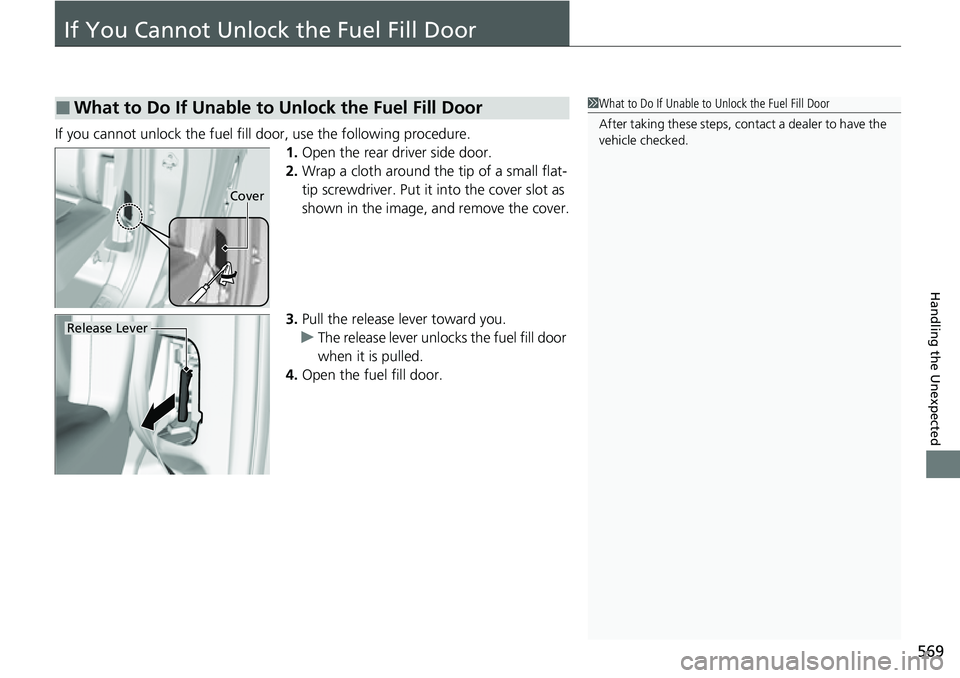
569
Handling the Unexpected
If You Cannot Unlock the Fuel Fill Door
If you cannot unlock the fuel fill door, use the following procedure.1.Open the rear driver side door.
2. Wrap a cloth around the tip of a small flat-
tip screwdriver. Put it into the cover slot as
shown in the image, and remove the cover.
3. Pull the release lever toward you.
u The release lever unlocks the fuel fill door
when it is pulled.
4. Open the fuel fill door.
■What to Do If Unable to Unlock the Fuel Fill Door1What to Do If Unable to Unlock the Fuel Fill Door
After taking these steps, cont act a dealer to have the
vehicle checked.
Cover
Release Lever
Page 572 of 598
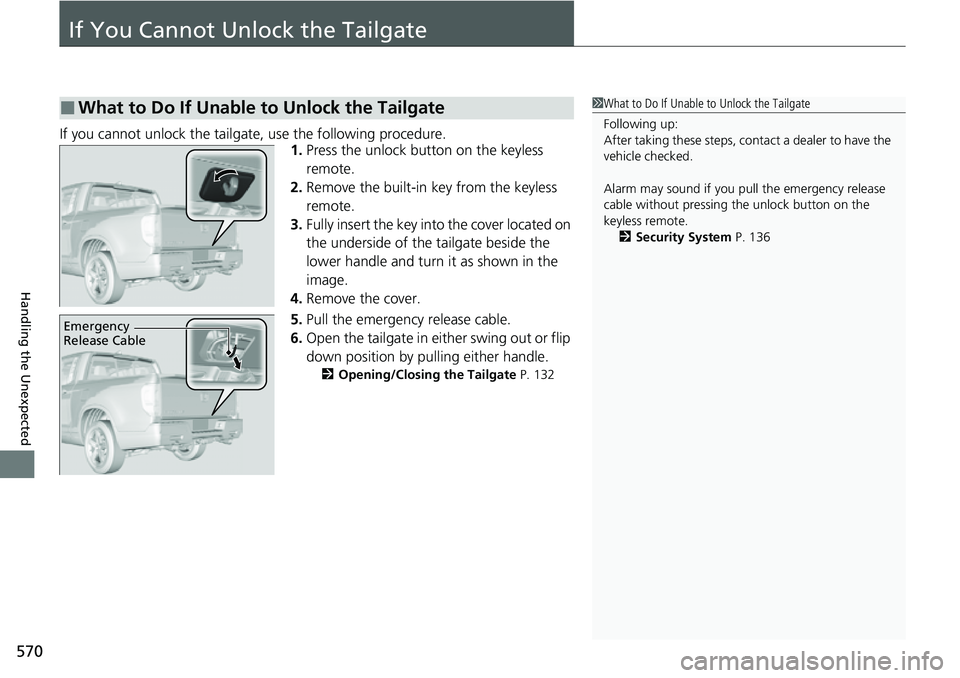
570
Handling the Unexpected
If You Cannot Unlock the Tailgate
If you cannot unlock the tailgate, use the following procedure.1.Press the unlock button on the keyless
remote.
2. Remove the built-in key from the keyless
remote.
3. Fully insert the key into the cover located on
the underside of the tailgate beside the
lower handle and turn it as shown in the
image.
4. Remove the cover.
5. Pull the emergency release cable.
6. Open the tailgate in either swing out or flip
down position by pulling either handle.
2 Opening/Closing the Tailgate P. 132
■What to Do If Unable to Unlock the Tailgate1What to Do If Unable to Unlock the Tailgate
Following up:
After taking these steps, cont act a dealer to have the
vehicle checked.
Alarm may sound if you pull the emergency release
cable without pressing the unlock button on the
keyless remote. 2 Security System P. 136
Emergency
Release Cable
Page 573 of 598
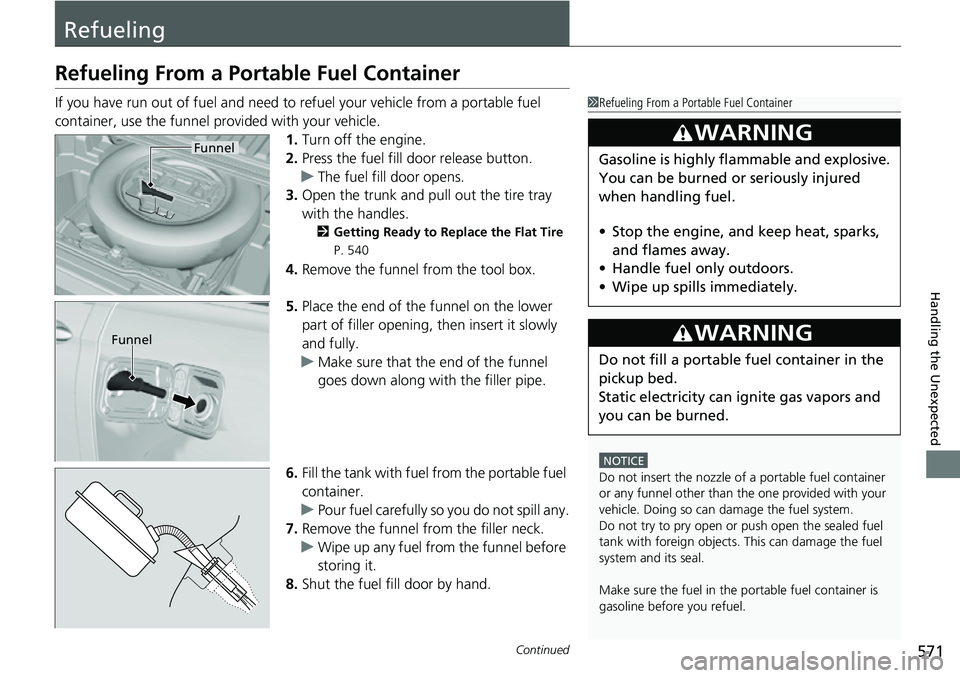
571Continued
Handling the Unexpected
Refueling
Refueling From a Portable Fuel Container
If you have run out of fuel and need to refuel your vehicle from a portable fuel
container, use the funnel provided with your vehicle.
1.Turn off the engine.
2. Press the fuel fill door release button.
u The fuel fill door opens.
3. Open the trunk and pull out the tire tray
with the handles.
2 Getting Ready to Replace the Flat Tire
P. 540
4. Remove the funnel from the tool box.
5. Place the end of the funnel on the lower
part of filler opening, then insert it slowly
and fully.
u Make sure that the end of the funnel
goes down along with the filler pipe.
6. Fill the tank with fuel from the portable fuel
container.
u Pour fuel carefully so you do not spill any.
7. Remove the funnel from the filler neck.
u Wipe up any fuel from the funnel before
storing it.
8. Shut the fuel fill door by hand.
1Refueling From a Portable Fuel Container
NOTICE
Do not insert the nozzle of a portable fuel container
or any funnel other than the one provided with your
vehicle. Doing so can damage the fuel system.
Do not try to pry open or push open the sealed fuel
tank with foreign objects. This can damage the fuel
system and its seal.
Make sure the fuel in the portable fuel container is
gasoline before you refuel.
3WARNING
Gasoline is highly flammable and explosive.
You can be burned or seriously injured
when handling fuel.
• Stop the engine, and keep heat, sparks,
and flames away.
• Handle fuel only outdoors.
• Wipe up spills immediately.
3WARNING
Do not fill a portable fuel container in the
pickup bed.
Static electricity can ignite gas vapors and
you can be burned.
Funnel
Funnel
Page 574 of 598
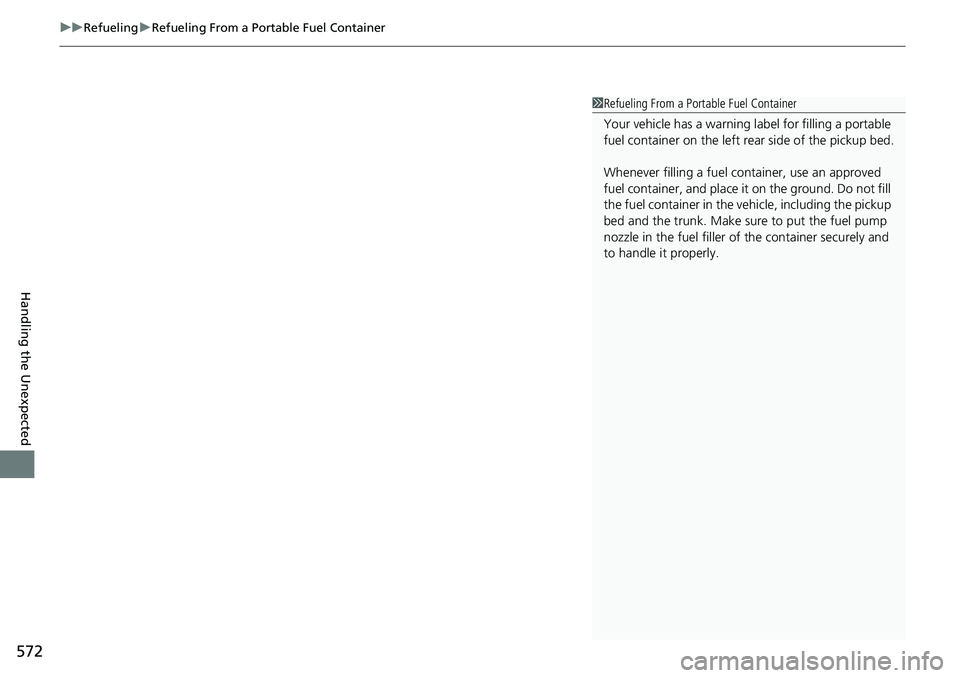
uuRefueling uRefueling From a Portable Fuel Container
572
Handling the Unexpected
1Refueling From a Portable Fuel Container
Your vehicle has a warning label for filling a portable
fuel container on the left re ar side of the pickup bed.
Whenever filling a fuel container, use an approved
fuel container, and place it on the ground. Do not fill
the fuel container in the vehicle, including the pickup
bed and the trunk. Make sure to put the fuel pump
nozzle in the fuel filler of the container securely and
to handle it properly.
Page 575 of 598
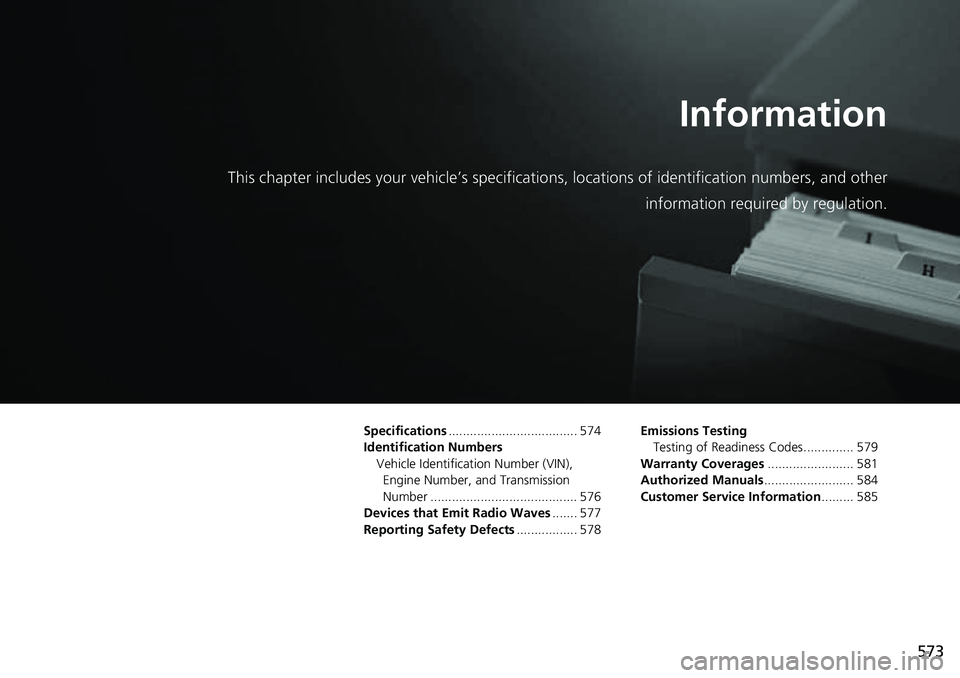
573
Information
This chapter includes your vehicle’s specifications, locations of identification numbers, and other
information required by regulation.
Specifications .................................... 574
Identification Numbers Vehicle Identification Number (VIN), Engine Number, and Transmission
Number ......................................... 576
Devices that Emit Radio Waves ....... 577
Reporting Safety Defects ................. 578Emissions Testing
Testing of Readiness Codes.............. 579
Warranty Coverages ........................ 581
Authorized Manuals ......................... 584
Customer Service Information ......... 585
Page 576 of 598
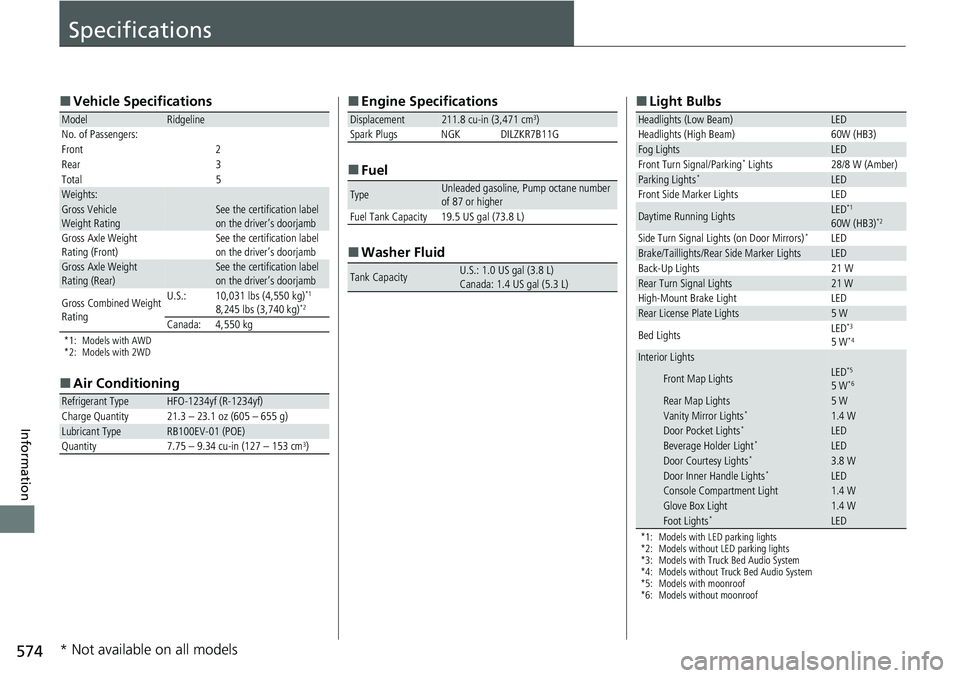
574
Information
Specifications
■Vehicle Specifications
*1: Models with AWD
*2: Models with 2WD
■Air Conditioning
ModelRidgeline
No. of Passengers:
Front 2
Rear 3
Total 5
Weights:Gross Vehicle
Weight RatingSee the certification label
on the driver’s doorjamb
Gross Axle Weight
Rating (Front)See the certification label
on the driver’s doorjamb
Gross Axle Weight
Rating (Rear)See the certification label
on the driver’s doorjamb
Gross Combined Weight
Rating U.S.: 10,031 lbs (4,550 kg)
*1
8,245 lbs (3,740 kg)*2
Canada: 4,550 kg
Refrigerant TypeHFO-1234yf (R-1234yf)
Charge Quantity 21.3 – 23.1 oz (605 – 655 g)
Lubricant TypeRB100EV-01 (POE)
Quantity 7.75 – 9.34 cu-in (127 – 153 cm3)
■ Engine Specifications
■ Fuel
■ Washer Fluid
Displacement211.8 cu-in (3,471 cm3)
Spark Plugs NGK DILZKR7B11G
TypeUnleaded gasoline, Pump octane number
of 87 or higher
Fuel Tank Capacity 19.5 US gal (73.8 L)
Tank CapacityU.S.: 1.0 US gal (3.8 L)
Canada: 1.4 US gal (5.3 L)
■ Light Bulbs
*1: Models with LED parking lights
*2: Models without LED parking lights
*3: Models with Truck Bed Audio System
*4: Models without Truck Bed Audio System
*5: Models with moonroof
*6: Models without moonroof
Headlights (Low Beam)LED
Headlights (High Beam) 60W (HB3)
Fog LightsLED
Front Turn Signal/Parking* Lights 28/8 W (Amber)Parking Lights*LED
Front Side Marker Lights LED
Daytime Running LightsLED*1
60W (HB3)*2
Side Turn Signal Lights (on Door Mirrors)*LEDBrake/Taillights/Rear Side Marker LightsLED
Back-Up Lights 21 W
Rear Turn Signal Lights21 W
High-Mount Brake Light LED
Rear License Plate Lights5 W
Bed Lights LED*3
5 W*4
Interior Lights
Front Map LightsLED*5
5 W*6
Rear Map Lights5 WVanity Mirror Lights*1.4 WDoor Pocket Lights*LEDBeverage Holder Light*LEDDoor Courtesy Lights*3.8 WDoor Inner Handle Lights*LEDConsole Compartment Light1.4 WGlove Box Light1.4 WFoot Lights*LED
* Not available on all models
Page 577 of 598
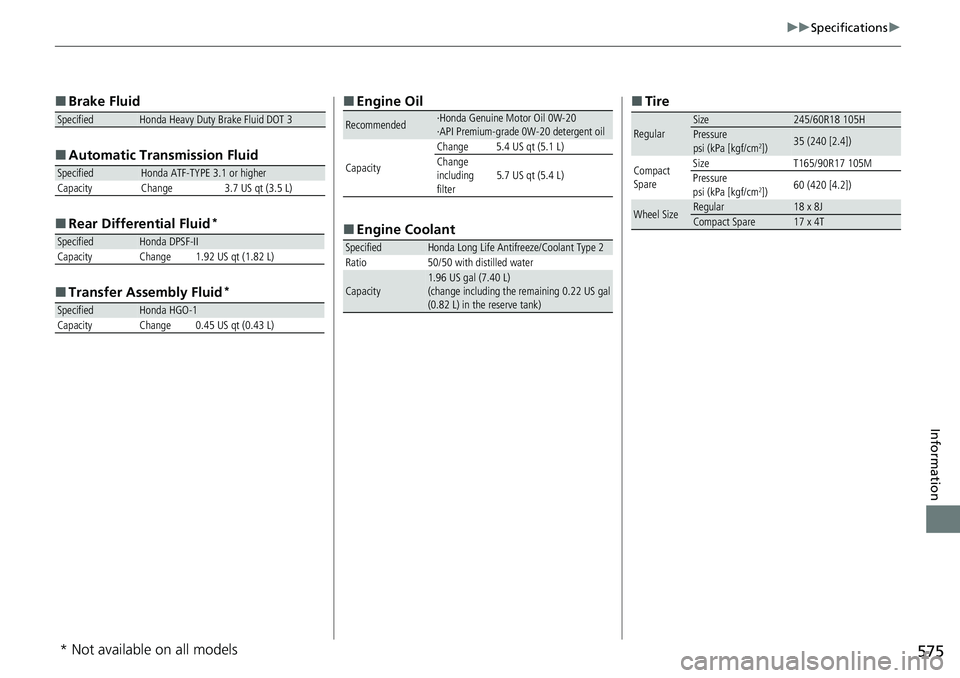
575
uuSpecifications u
Information
■
Brake Fluid
■ Automatic Tran smission Fluid
■ Rear Differential Fluid
*
■Transfer Assembly Fluid*
SpecifiedHonda Heavy Duty Brake Fluid DOT 3
SpecifiedHonda ATF-TYPE 3.1 or higher
Capacity Change 3.7 US qt (3.5 L)
SpecifiedHonda DPSF-II
Capacity Change 1.92 US qt (1.82 L)
SpecifiedHonda HGO-1
Capacity Change 0.45 US qt (0.43 L)
■ Engine Oil
■ Engine Coolant
Recommended·Honda Genuine Motor Oil 0W-20
·API Premium-grade 0W-20 detergent oil
Capacity Change 5.4 US qt (5.1 L)
Change
including
filter
5.7 US qt (5.4 L)
SpecifiedHonda Long Life Antifreeze/Coolant Type 2
Ratio 50/50 with distilled water
Capacity1.96 US gal (7.40 L)
(change including the remaining 0.22 US gal
(0.82 L) in the reserve tank)
■ Tire
RegularSize245/60R18 105HPressure
psi (kPa [kgf/cm2])35 (240 [2.4])
Compact
Spare Size
T165/90R17 105M
Pressure
psi (kPa [kgf/cm
2]) 60 (420 [4.2])
Wheel SizeRegular18 x 8JCompact Spare17 x 4T
* Not available on all models
Page 578 of 598

576
Information
Identification Numbers
Vehicle Identification Number (VIN), Engine Number,
and Transmission Number
Your vehicle has a 17-digit vehicle identifi cation number (VIN) used to register your
vehicle for warranty purposes, and for licensing and insuring your vehicle.
The locations of your vehicle’s VIN, engine number, and transmission number are
shown as follows.
1 Vehicle Identification Number (VIN), Engine Number, and
Transmission Number
The interior vehicle identification number (VIN) is
located under the cover.
Cover
Vehicle Identification Number
Engine Number
Certification Label/Vehicle Identification Number
Automatic
Transmission Number
Page 579 of 598
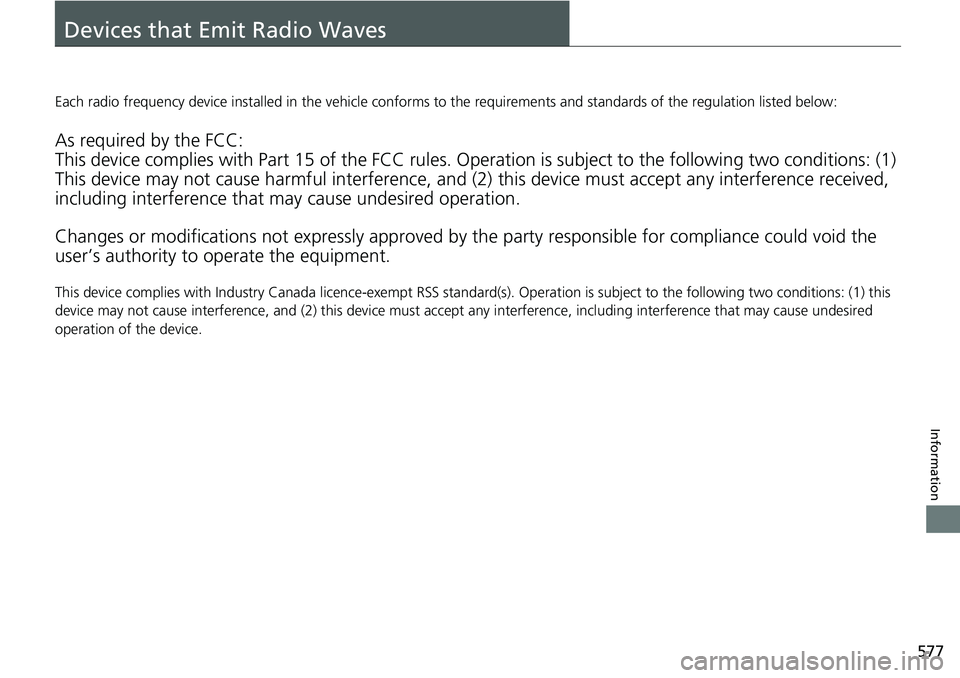
577
Information
Devices that Emit Radio Waves
Each radio frequency device installed in the vehicle conforms to the requirements and standards of the regulation listed below:
As required by the FCC:
This device complies with Part 15 of the FCC rules. Operation is subject to the following two conditions: (1)
This device may not cause harmful interference, and (2) this device must accept any interference received,
including interference that may cause undesired operation.
Changes or modifications not expres sly approved by the party responsible for compliance could void the
user’s authority to operate the equipment.
This device complies with Indus try Canada licence-exempt RSS standard(s). Operation is subject to the following two conditions: (1) this
device may not cause interference, and (2) this device must accept any interference, including interference that may cause unde sired
operation of the device.
Page 580 of 598
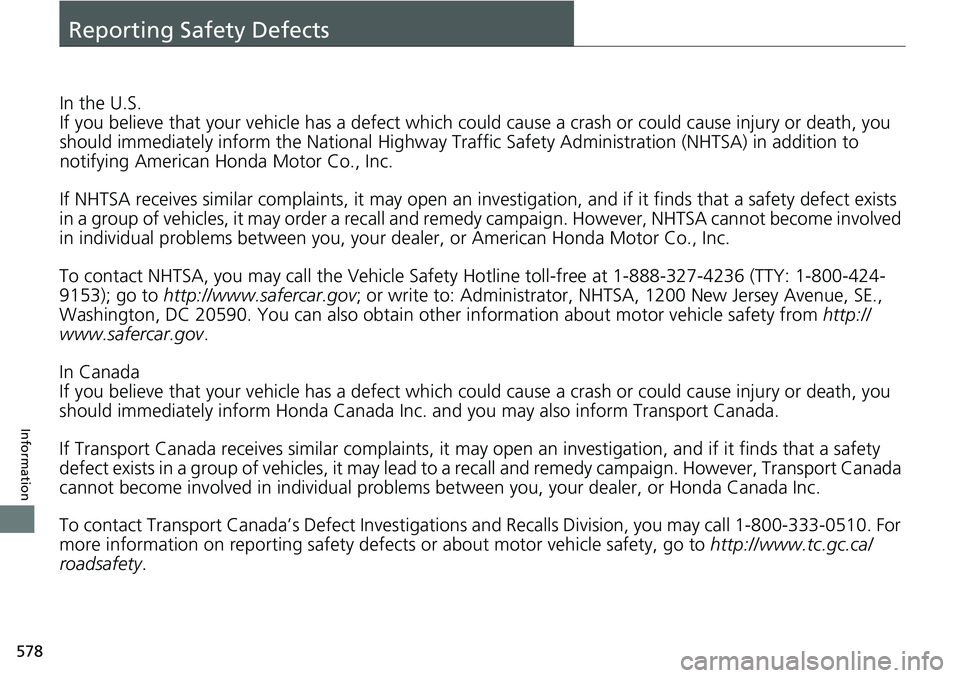
578
Information
Reporting Safety Defects
In the U.S.
If you believe that your vehicle has a defect which could cause a crash or could cause injury or death, you
should immediately inform the Nati onal Highway Traffic Safety Administration (NHTSA) in addition to
notifying American Honda Motor Co., Inc.
If NHTSA receives similar complaints, it may open an inve stigation, and if it finds that a safety defect exists
in a group of vehicles, it may order a recall and reme dy campaign. However, NHTSA cannot become involved
in individual problems between you, your dealer, or American Honda Motor Co., Inc.
To contact NHTSA, you may call the Vehicle Safety Ho tline toll-free at 1-888-327-4236 (TTY: 1-800-424-
9153); go to http://www.safercar.gov ; or write to: Administrator, NHTSA , 1200 New Jersey Avenue, SE.,
Washington, DC 20590. You can also obtain othe r information about motor vehicle safety from http://
www.safercar.gov .
In Canada
If you believe that your vehicle has a defect which c ould cause a crash or could cause injury or death, you
should immediately inform Honda Canada Inc. and you may also inform Transport Canada.
If Transport Canada receives similar complaints, it may open an investigation, and if it finds that a safety
defect exists in a group of vehicles, it may lead to a recall and remedy campaign. However, Transport Canada
cannot become involved in individual problems between you, your dealer, or Honda Canada Inc.
To contact Transport Canada’s Defect Investigations and Recalls Division, you may call 1-800-333-0510. For
more information on reporting safety defects or about motor vehicle safety, go to http://www.tc.gc.ca/
roadsafety .